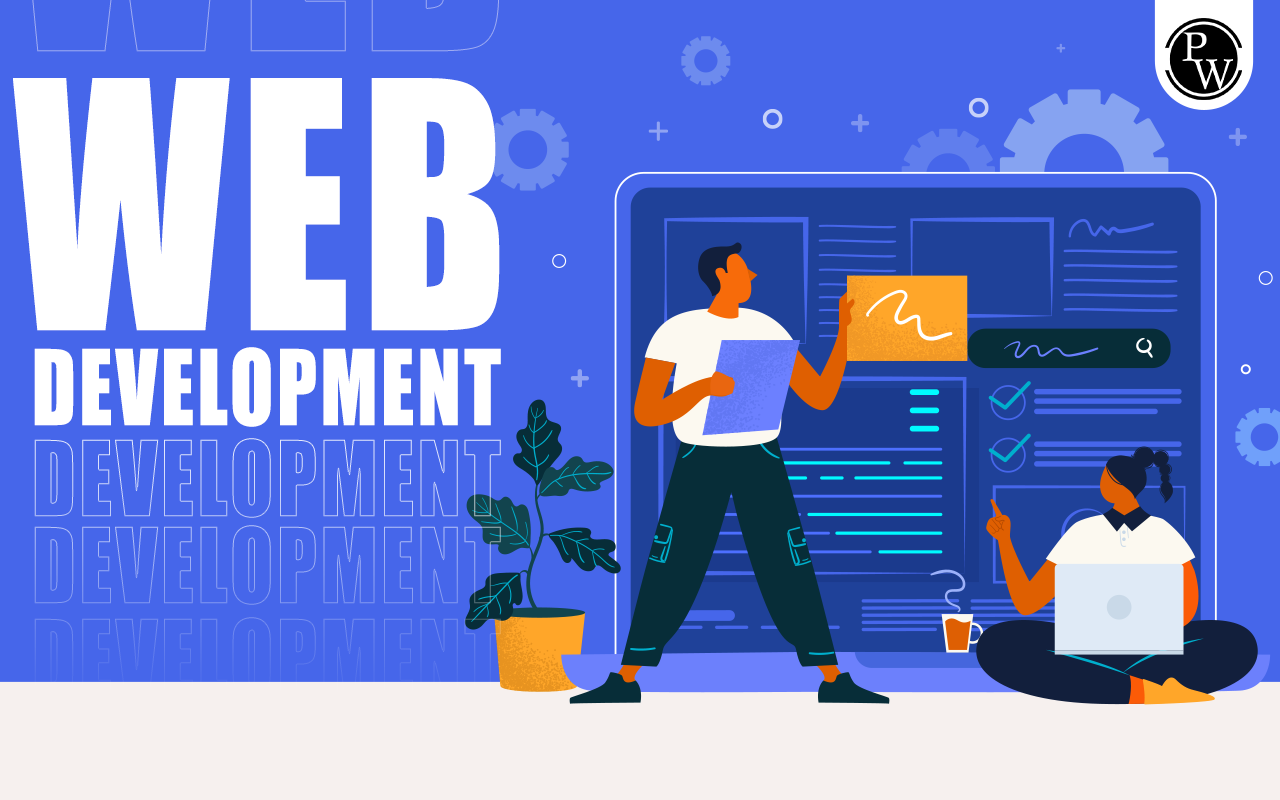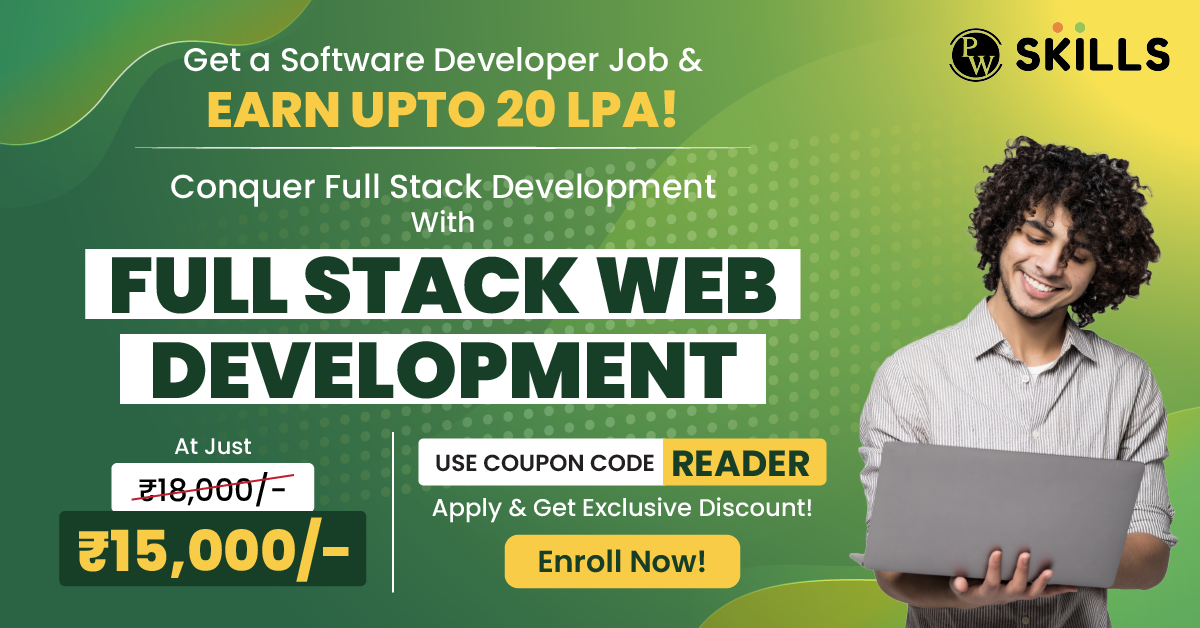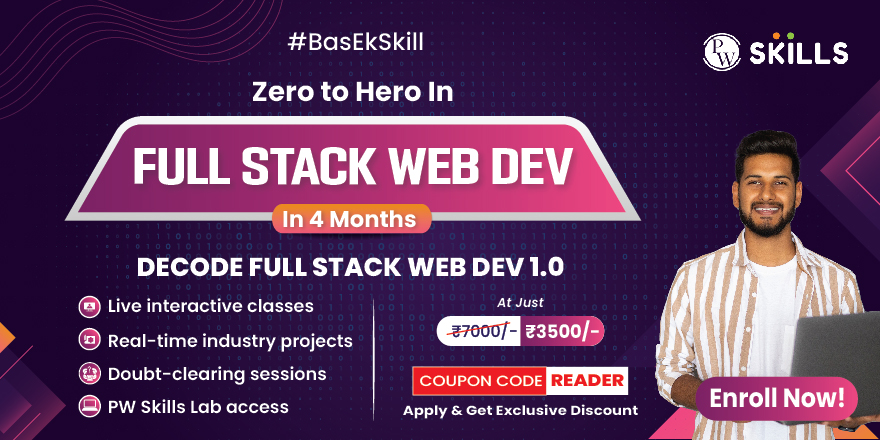Web Development: In today’s fast-paced digital landscape, web development has become a skill employers can’t overlook. It’s a skill that will pay off in almost every profile and let you get high-paying jobs! Whether you are a budding developer or an experienced coder looking to expand your expertise, understanding front and backend development is crucial.
In this blog, we’ll talk about web development, types of web development, frontend and backend development, and much more! If you want to secure the best jobs in the web development field, the PhysicsWallah Full Stack Web Development course is your path to do so!
What Is Web Development?
Web development involves the creation of websites or web applications, covering various responsibilities such as designing user interfaces, enhancing user experiences, and managing server-side operations. It is a crucial element in giving substance to the digital realm. In a time where success is closely linked with online visibility, web development stands as a key player in technological progress. Whether it’s businesses, organisations, or individuals, the expertise of web developers is indispensable for crafting engaging and dynamic online interactions. Web development is broadly categorised into frontend and backend development. Frontend deals with the user interface and user experience, while backend focuses on server-side operations and database management. Full stack developers are those who master both aspects, offering a holistic approach to web development.
Also Check: Top 30 Most Asked Basic Programming Questions Asked During Interviews
Types of Web Development
A. Frontend Development
Frontend development involves creating the visual elements users interact with. UI focuses on the design and layout, while UX ensures a seamless and enjoyable user experience. Understanding the distinctions between frontend and backend development is crucial. Frontend deals with the presentation layer, while backend manages the server-side logic. Full stack developers are proficient in both frontend and backend technologies, making them versatile contributors to web development projects.
B. Backend Development
Backend development involves server-side scripting, where the server executes the code, and client-side scripting, where the code runs on the user’s browser. Backend developers handle database management, ensuring data integrity, and server operations, managing the functionality that happens behind the scenes.
The collaboration between frontend and backend is crucial for a cohesive user experience. Data flow and communication between the two ensure a dynamic and responsive web application.
Frontend Development
Crafting the face of a website or web app is the essence of frontend development. This pivotal part of web creation centres on making an attractive and easy-to-use interface, guaranteeing smooth interaction for users. Let’s delve deeper into the key components and considerations within frontend development.
A. Frontend Roadmap
Understanding HTML, CSS, and JavaScript
- HTML (HyperText Markup Language): The foundation of web content, HTML arranges web page elements, outlining headings, paragraphs, images, and links.
- CSS (Cascading Style Sheets): Managing style and layout, CSS boosts visual allure by governing colours, fonts, spacing, and adaptability.
- JavaScript: A dynamic scripting language that enables interactivity, JavaScript allows developers to manipulate page elements, handle events, and create dynamic content.
Responsive Design and Cross-Browser Compatibility
- Responsive Design: With the proliferation of various devices, responsive design ensures that a website adapts seamlessly to different screen sizes, providing a consistent user experience across desktops, tablets, and smartphones.
- Cross-Browser Compatibility: Frontend developers must ensure that their web applications work consistently across different web browsers, considering variations in rendering engines and standards compliance.
Introduction to Frontend Frameworks
- Benefits of Frameworks: Frontend frameworks like React.js, Angular.js, and Vue.js offer pre-built components and a structured architecture, promoting code reusability and maintainability.
- Choosing the Right Framework: Selection depends on project requirements, development team expertise, and scalability needs.
B. Popular Frontend Technologies
HTML5 and Its Features
- Semantics and Multimedia: HTML5 introduces semantic tags like <article>, <section>, and <nav>, enhancing the structure of web content. It also supports multimedia elements, making it easier to embed audio and video without plugins.
CSS3: Styling for the Modern Web
- Animations and Transitions: CSS3 brings animation and transition properties, enabling developers to create visually appealing and engaging user interfaces without relying on external libraries.
- Flexbox and Grid Layouts: CSS3 introduces flexible box layouts (Flexbox) and grid layouts, streamlining the creation of responsive designs.
JavaScript ES6+: Enhancing Interactivity
- Arrow Functions and Template Literals: ES6 introduces concise syntax with arrow functions and template literals, making JavaScript code more readable and expressive.
- Promises and Asynchronous Programming: Promises simplify asynchronous code execution, enhancing the handling of asynchronous operations in web applications.
C. Frontend Libraries and Frameworks
React.js
- Component-Based Architecture: React.js follows a component-based architecture, where UIs are divided into independent and reusable components. This promotes modularity and ease of maintenance.
- Virtual DOM: React’s virtual DOM optimises rendering by updating only the changed parts of the actual DOM, improving performance.
Angular.js
- Two-Way Binding: Angular.js streamlines data interaction with its two-way binding, syncing model and view effortlessly, minimising redundant code. Dependency injection in Angular.js boosts modularity, enhancing the autonomy and testability of components.
- Dependency Injection: Dependency injection in Angular.js enhances modularity and testability by making components more independent.
Vue.js
- Approachability and Flexibility: Vue.js is known for its simplicity and approachability, making it an excellent choice for beginners. It provides flexibility, allowing developers to incrementally adopt its features.
- Reactivity System: Vue.js employs a reactivity system that automatically updates the UI when the underlying data changes, simplifying state management.
Bootstrap and Materialise: Frontend Styling Made Easy
- Bootstrap: Bootstrap is a CSS framework that provides a grid system, responsive utilities, and a plethora of pre-designed components, expediting the development of consistent and visually appealing interfaces.
- Materialise: Materialise is based on Google’s Material Design principles, offering a modern and clean design aesthetic. It includes CSS components and JavaScript functionalities for a cohesive user experience.
Backend Development
A. Backend Roadmap
- Server Setup and Configuration
Initiating backend development starts with understanding server setup and configuration. This encompasses selecting a fitting hosting environment, configuring servers, and ensuring alignment with the technical requisites of the web application. Mastery of server operating systems, like Linux or Windows Server, becomes imperative for a smooth deployment process.
- Understanding Databases (SQL and NoSQL)
At the core of backend development lie databases, responsible for storing and retrieving data for web applications. Proficiency in both SQL (Structured Query Language) for relational databases and NoSQL databases, prized for their adaptability in managing unstructured data, is essential. Well-known database management systems include:
- MySQL
- PostgreSQL
- MongoDB
- Cassandra
- Server-Side Programming Languages
Picking the right programming language for server-side work is a crucial choice. Each language has strengths tailored to specific tasks. Here are some widely used server-side programming languages:
- Node.js (JavaScript):
-
-
- Known for event-driven, non-blocking I/O.
- Enables JavaScript use for both frontend and backend development.
- Eases the development process.
-
- Python (Django, Flask):
-
-
- Renowned for readability and simplicity.
- Django, a high-level web framework.
- Flask, a lightweight framework for robust web applications.
-
- Ruby (Ruby on Rails):
-
-
- Dynamic, object-oriented language.
- Emphasises convention over configuration.
- Developer-friendly syntax, rapid development with Rails.
-
- Java (Spring Boot):
-
-
- Versatile, object-oriented language.
- Widely used in enterprise-level applications.
- Spring Boot simplifies production-ready Java app development.
-
- PHP (Laravel):
-
- Server-side scripting language for web development.
- Laravel, a PHP web app framework.
- Offers an elegant syntax and tools for routing, caching, and authentication.
Understanding each language’s strengths and weaknesses guides developers in making informed decisions based on project requirements.
B. Popular Backend Technologies
Node.js and Express
- Node.js: Node.js utilises the V8 JavaScript engine, serving as a runtime for JavaScript. This permits developers to employ JavaScript in server-side scripting, fostering a cohesive language stack for both the frontend and backend.
- Express: Express, a streamlined Node.js web application framework, eases the development of server-side applications by offering sturdy features for routing, middleware, and templating.
Django (Python)
- Django: Django, a Python web framework of elevated stature, adheres to the “don’t repeat yourself” (DRY) principle. It incorporates an Object-Relational Mapping (ORM) system, an administrative panel, and prioritises swift development.
Ruby on Rails
- Ruby on Rails: Ruby on Rails, commonly known as Rails, is a full-stack web application framework written in Ruby. It follows the convention over configuration (CoC) and doesn’t repeat itself (DRY) principles, promoting clean and efficient code.
PHP and Laravel
- PHP: PHP serves as a server-side scripting language in web development, playing a crucial role in a substantial part of the internet. It particularly excels in handling dynamic content and applications driven by data.
- Laravel: Laravel is a PHP web application framework that provides an elegant syntax and tools for tasks like routing, caching, and authentication. By streamlining routine development activities, Laravel empowers developers to concentrate on the core logic of their applications.
C. Backend Libraries and Frameworks
- Express.js
As mentioned earlier, Express, a Node.js web app framework, boasts a reputation for simplicity, making it ideal for creating scalable server-side apps.
- Flask (Python)
Flask, a Python micro web framework, prioritises lightweight design and user-friendliness. It offers the basics for web app development without excessive structure, providing developers with increased flexibility.
- Spring Boot (Java)
Spring Boot streamlines the creation of Java applications for production. With features like auto-configuration to cut down on redundant code and a variety of modules, it enhances the development experience. Backend libraries and frameworks play a crucial role in simplifying and accelerating the development process. They provide pre-built modules, utilities, and conventions that help developers focus on building application logic rather than reinventing the wheel.
Also Check: Who And When C++ Is Developed By?
PhysicsWallah Full Stack Web Development Course Benefits
Embarking on a journey to master web development requires not just knowledge but a transformative learning experience. PhysicsWallah’s Full Stack Web Development Course offers more than just a curriculum; it presents a dynamic ecosystem tailored for your success. Let’s explore the compelling benefits that set this course apart:
- 100% Job Assurance
PhysicsWallah’s Full Stack Web Development Course stands out by offering a unique benefit – 100% job assurance. We offer a 100% Job Assurance guarantee for students who complete the full course. After you complete your course, we will make sure that you get placed in the top companies in India.
- Assignment
Assignments are integral to the learning process, reinforcing theoretical concepts and allowing students to apply their knowledge in real-world scenarios. PhysicsWallah’s Full Stack Web Development Course includes a structured assignment system that challenges students to implement what they have learned, fostering a deeper understanding of the material.
- Doubt Clearing Sessions
Understanding complex concepts is crucial for web development success. PhysicsWallah recognizes this and provides regular doubt clearing sessions where students can interact with instructors, seek clarification on challenging topics, and ensure they have a solid grasp of the course material.
- 340+ Hours Classes
The extensive duration of the course, with over 340 hours of classes, ensures that students receive in-depth coverage of both frontend and backend technologies. This extended time commitment allows for thorough exploration, hands-on practice, and a comprehensive understanding of the entire web development process.
- 14+ Projects
Learning by doing is a core philosophy of PhysicsWallah’s Full Stack Web Development Course. The inclusion of 14+ projects provides students with ample opportunities to apply their skills in real-world scenarios. Projects range from simple exercises to complex, full-fledged web applications, enabling students to build a robust portfolio showcasing their abilities to potential employers.
- PWLab Access
Access to PWLab, PhysicsWallah’s learning platform, is a valuable asset for students. PWLab provides a centralised hub for course materials, recorded lectures, additional resources, and a collaborative environment for students to engage with each other and the course content at their own pace.
- Quiz in Every Module
Regular assessments are vital for gauging understanding and tracking progress. PhysicsWallah’s Full Stack Web Development Course incorporates quizzes at the end of every module, reinforcing key concepts and allowing students to self-assess their proficiency.
- Course Materials
Comprehensive course materials are essential for effective learning. PhysicsWallah ensures that students have access to well-structured and up-to-date course materials, including lecture notes, code samples, and additional resources. These materials serve as valuable references for students both during the course and in their future careers.
- Resume Building
Crafting an impressive resume is a crucial step in the job application process. PhysicsWallah’s Full Stack Web Development Course goes beyond technical skills and includes guidance on resume building. Students learn how to showcase their projects, skills, and achievements effectively, increasing their chances of standing out to potential employers.
- Career Guidance
Navigating the vast landscape of career options in web development can be overwhelming. PhysicsWallah provides dedicated career guidance to help students make informed decisions about their career paths. From exploring different specialisations to understanding industry trends, the course offers valuable insights to support students in shaping their professional journeys.
- Mock Interview
Facing interviews can be daunting, especially for those entering the job market. PhysicsWallah’s Full Stack Web Development Course includes mock interview sessions, simulating real interview scenarios. This practical experience helps students build confidence, refine their communication skills, and prepare for the challenges of the job interview process.
- Discord Community
Community engagement is a powerful aspect of the learning experience. PhysicsWallah facilitates a Discord community where students can connect with instructors, mentors, and fellow learners. This collaborative space allows for the exchange of ideas, troubleshooting, and networking, creating a supportive environment throughout the learning journey.
Also Read: C++ Programming: An Introduction
PhysicsWallah Full-Stack Web Development Course Curriculum
The Full-Stack Web Development Course covers a range of modules, including frontend and backend technologies, project management, and soft skills development. Here’s the full course-curriculum:
| Full-Stack Web Development Course Curriculum | |
| Module | Things Covered |
| HTML |
|
| GIT and Github |
|
| CSS |
|
| Javascript |
|
| Bootstrap |
|
| Tailwind CSS |
|
| DSA |
|
| React |
|
| Networking |
|
| Node Js |
|
| Express |
|
| Database |
|
| SQL Data Types |
|
| Project On Authentication |
|
| MongoDB |
|
| Working with Files |
|
| Project On Authentication |
|
| Capstone Project |
|
PhysicsWallah Full Stack Web Development Course Eligibility and Admission
Eligibility Criteria
- No prior programming or coding experience needed.
- Suitable for both freshers and experienced professionals.
- Students due to graduate within 1 year or 1.5 years can also apply.
Program Duration
The program is 12 months long.
Program Fees
INR 10,000
Program Format
The classes will be conducted live by our experienced mentors.
Conclusion
Web development is a dynamic field that continues to evolve with technological advancements. Mastering both frontend and backend development opens doors to a wide range of opportunities. The demand for full stack developers is on the rise. Exploring full stack development offers a holistic perspective, making developers versatile and highly sought after.
PhysicsWallah’s Full Stack Web Development course provides a comprehensive and practical approach to mastering web development. The combination of industry-driven curriculum, hands-on learning, and expert guidance positions students for success in the ever-expanding world of web development.
FAQs
Why is Full Stack Development gaining popularity?
Full Stack Development is gaining popularity because it empowers developers to work on both frontend and backend, making them versatile and capable of handling end-to-end development. This approach streamlines collaboration between different components of a web application, resulting in more efficient and cohesive projects.
How do frontend frameworks like React.js enhance web development?
Front-end frameworks like React.js enhance web development by providing a component-based architecture. This allows developers to create reusable UI components, improving code organisation, maintainability, and facilitating the development of interactive and dynamic user interfaces.
How do backend frameworks like Django simplify web development in Python?
Backend frameworks like Django simplify web development in Python by providing a high-level, feature-rich framework. Django follows the "Don't Repeat Yourself" (DRY) principle and emphasises rapid development, making it an excellent choice for building scalable and maintainable web applications.
What is the significance of real-world application and case studies in web development courses?
Real-world application and case studies in web development courses bridge the gap between theoretical knowledge and practical implementation. They provide students with hands-on experience, allowing them to apply their skills to solve real-world challenges, enhancing their problem-solving abilities and preparing them for the complexities of the industry.
Can I enroll in the PhysicsWallah Full Stack Web Development course without prior programming knowledge?
Yes, you can. While the PhysicsWallah Full Stack Web Development course is designed for beginners, having a basic understanding of programming concepts can be advantageous. The course provides a structured learning path to help beginners grasp fundamental concepts before delving into more advanced topics.
How does PhysicsWallah's course support continuous learning and improvement?
PhysicsWallah's Full Stack Web Development course supports continuous learning and improvement through a system of continuous assessment and feedback. This ensures that students receive timely guidance, fostering a culture of improvement and refinement throughout the duration of the course.
What kind of career opportunities can a Full Stack Developer expect?
A Full Stack Developer can expect a wide range of career opportunities due to their proficiency in both frontend and backend development. They are well-suited for roles such as Full Stack Developer, Web Developer, Software Engineer, or even positions in project management, where their holistic understanding of development processes is highly valued.





